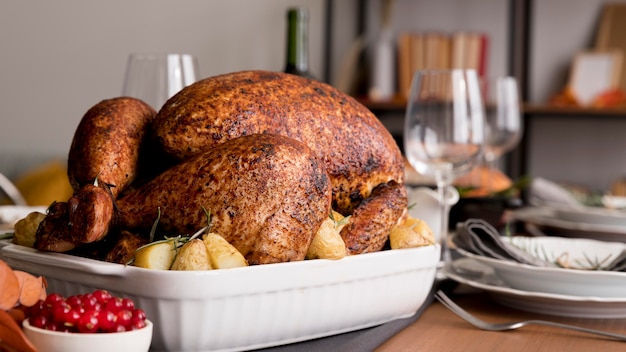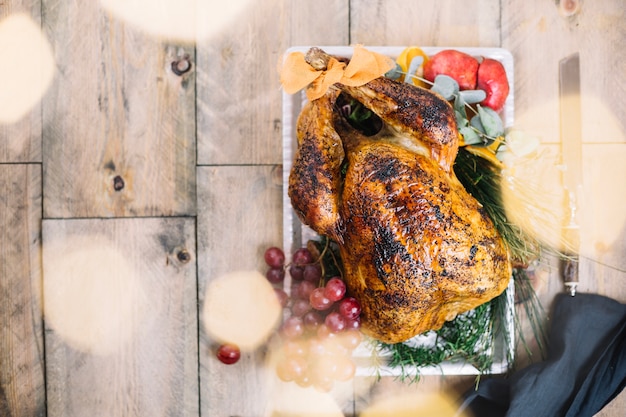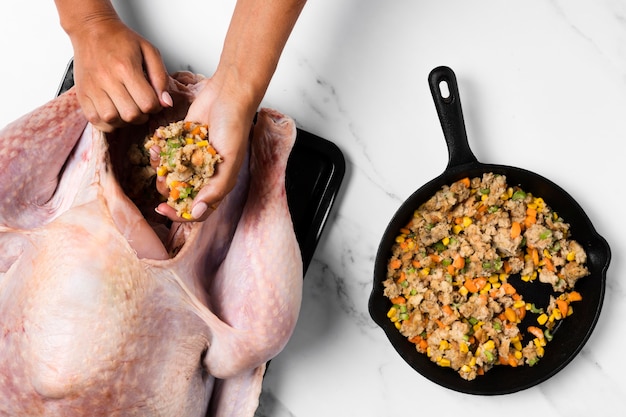(Part 1) Choosing Your Turkey

The Big Decision: Fresh or Frozen?
First things first, you need to decide whether to go for a fresh turkey or a frozen one. Now, I'm a bit of a traditionalist, so I typically gravitate towards fresh, especially if I can find a local butcher who knows their stuff. The flavour, I swear, is just a bit more intense. Plus, you know you're getting a truly fresh bird, straight from the farm. However, frozen turkeys offer undeniable convenience, especially if you're not planning ahead. Just be sure to thaw it properly – we'll get to that later.Size Matters: How Much Turkey Do You Need?
No, I'm not talking about the turkey's ego; I'm talking about its size! You don't want to end up with a bird that's too small (unless you're having a small gathering) or one that's too big (because you'll be left with mountains of leftovers). As a general rule of thumb, plan for about 1 pound of turkey per person. If you're having a big crowd, you might want to go for a slightly larger bird, just to be safe.Checking for Quality: Look for These Signs
Before you commit to a particular bird, give it a good once-over. Look for a turkey with firm, springy flesh and a nice, even colour, indicating freshness. Avoid any birds that have a slimy or sticky surface or a foul odour – those are signs of spoilage. A good turkey should have a pleasant aroma, not a lingering, unpleasant smell.(Part 2) Preparing Your Turkey

Thawing: A Frozen Turkey's Journey to Room Temperature
Okay, so you've chosen your bird. Now, if you've gone for a frozen turkey, it's time to thaw it out. There are two main methods: thawing in the fridge or using a cold water bath. The fridge method is the most common and safest. Allow at least 24 hours for every 5 pounds of turkey. Place the turkey on a large plate or in a container to catch any drips and store it in the coldest part of your refrigerator. For a faster thaw, use a cold water bath. Place the turkey in a large container filled with cold water, making sure the turkey is fully submerged. Change the water every 30 minutes to keep it cold. This method is much faster than fridge thawing, but it's important to ensure the water stays cold throughout the process. Proper thawing is crucial for even cooking and ensuring your turkey is safe to eat. A partially frozen turkey will cook unevenly and might not reach a safe internal temperature.Brining: The Secret to a Moist and Juicy Bird
Ah, brining! This is where things get truly interesting. Brining is like giving your turkey a spa treatment, infusing it with flavour and moisture. It's essentially soaking the turkey in a salty solution, which helps to draw moisture into the meat, resulting in a juicy, tender bird. You can use a dry brine, which involves rubbing the turkey with a salt mixture, or a wet brine, which involves submerging the turkey in a solution of water, salt, and other flavourings.I personally love using a dry brine – it's simple and effective. Just rub the turkey with a mixture of kosher salt, sugar, and any other spices you like. You can also add some herbs, like rosemary or thyme, to enhance the flavour. Leave the turkey in the fridge for a few hours or even overnight. This will result in a juicy, flavorful turkey that's impossible to resist. If you're opting for a wet brine, you'll need a large container to accommodate the turkey. Combine water, salt, sugar, and any other flavourings you desire. Submerge the turkey in the brine for 12-24 hours. Make sure the turkey is completely covered with brine.Stuffing: A Traditional Touch
Now, this is where opinions differ. Some people swear by stuffing, others prefer to skip it. If you're feeling adventurous and have a traditional Thanksgiving in mind, then stuffing can be a great addition, adding flavour and texture to your meal. However, stuffing your turkey can make it take longer to cook through, and you might have to sacrifice some of the delicious crispy skin that everyone loves. If you do decide to stuff your turkey, make sure you use a safe stuffing recipe and cook it to an internal temperature of 165°F (74°C). The turkey should be cooked to an internal temperature of 165°F (74°C) as well. It's also essential to stuff the turkey loosely, so that the stuffing cooks evenly.(Part 3) Roasting Your Turkey

Get Ready for Roasting
Okay, you've chosen your bird, you've thawed it, you've brined it, you've stuffed it (if you want to). Now it's time for the main event: the roasting! Here's what you need to do:- Preheat your oven to 325°F (160°C). This is a classic roasting temperature that gives you a beautifully cooked turkey.
- Pat the turkey dry with paper towels. This helps to create a crispy skin. It's best to pat the turkey dry as much as possible, removing any excess moisture.
- Season the turkey generously with salt, pepper, and any other spices you like. This is your chance to get creative with your flavour profile. Some popular additions include paprika, garlic powder, onion powder, and herbs like rosemary and thyme.
- Place the turkey in a roasting pan. If you're using a wire rack, place it in the pan to allow air to circulate around the turkey, which helps it to cook evenly and achieve a crispy skin. If you don't have a rack, you can place the turkey on a bed of vegetables, such as carrots, onions, and celery, for extra flavour.
The roasting time
Now, the roasting time depends on the size of your turkey. You can use this table as a general guide:| turkey weight (pounds) | Roasting Time (hours) |
|---|---|
| 8-12 | 2-3 |
| 12-16 | 3-4 |
| 16-20 | 4-5 |
Don't worry, you won't be staring at the clock the whole time. You can always check the internal temperature of the turkey with a meat thermometer. It should register 165°F (74°C) in the thickest part of the thigh.
Basting: The Key to a Crispy Skin
While your turkey is roasting, you'll want to baste it with pan juices every 30 minutes or so. This helps to keep the turkey moist and the skin crispy. Just use a spoon to pour the juices over the turkey, making sure to get the breasts and thighs.(Part 4) Resting: A Crucial Step
Once your turkey is cooked through, don't be tempted to carve it right away. Instead, let it rest for at least 30 minutes, covered with foil. This gives the juices a chance to redistribute throughout the meat, resulting in a moister, more flavorful turkey.(Part 5) Carving: The Final Touches
Okay, the moment of truth! Now it's time to carve your turkey. You can use a sharp carving knife and a carving fork to make the job easier. Start by removing the legs and thighs, then carve the breasts. Once the turkey is carved, arrange it on a platter and serve with your favorite sides.(Part 6) Leftovers: Don't Waste a Bite
Let's face it, you're probably going to have some leftovers after your feast. And that's a good thing! turkey leftovers are perfect for sandwiches, salads, soups, or even a turkey pot pie. Just make sure to refrigerate the leftovers within two hours of cooking.(Part 7) Tips and Tricks for Oven-Roasted Turkey Success
Keep It Moist
One of the biggest challenges when roasting a turkey is keeping it moist. Here are a few tips to help you achieve that juicy bird:- Don't overcook it! Turkey is done when the internal temperature reaches 165°F (74°C) in the thickest part of the thigh. Overcooking can lead to dry, tough meat.
- Baste regularly. This helps to keep the turkey moist and the skin crispy. Basting with the pan juices every 30 minutes or so will keep the turkey succulent.
- Use a roasting rack. This allows air to circulate around the turkey, which helps it to cook evenly. A roasting rack prevents the turkey from sitting in its own juices, leading to a more evenly cooked bird.
- Cover the turkey with foil for the first part of the cooking time. This helps to prevent the breasts from drying out. Covering the turkey with foil during the first part of the cooking helps retain moisture and prevents the breast from drying out too quickly.
- Let the turkey rest before carving. This allows the juices to redistribute throughout the meat. This is a key step for ensuring a juicy, flavorful turkey.
Get That Crispy Skin
A crispy turkey skin is a sign of a well-cooked bird. Here's how to get that golden-brown perfection:- Pat the turkey dry with paper towels before roasting. This helps to create a crispy skin. Removing excess moisture from the skin allows it to crisp up beautifully.
- Don't be afraid to use a little bit of butter or olive oil. Rub it under the skin to help it brown. A little bit of fat under the skin helps the skin to crisp up and become deliciously golden.
- Place the turkey on a roasting rack. This allows air to circulate around the turkey, which helps it to cook evenly and get a crispy skin. The roasting rack elevates the turkey, allowing heat to circulate around it for a crisp skin and even cooking.
Troubleshooting
Okay, let's be honest, sometimes things don't go exactly as planned. Here's how to deal with a few common turkey problems:- Dry breast: If the breast meat is a bit dry, you can try adding a little bit of butter or chicken broth to the pan juices. You can also use a meat thermometer to check the temperature of the breast meat. If it's over 165°F (74°C), you can take the turkey out of the oven and let it rest for a few more minutes to allow the juices to redistribute.
- Burnt skin: If the skin is getting too dark, you can cover the turkey with foil for the last part of the cooking time. Just be careful not to cover the turkey too early, as this could prevent the skin from getting crispy.
- Undercooked stuffing: If you're stuffing your turkey, make sure to cook it to an internal temperature of 165°F (74°C). If it's not cooked through, you can remove it from the turkey and cook it separately in a baking dish until it reaches the safe temperature. It's always better to err on the side of caution when it comes to food safety.
(Part 8) FAQs: Your Turkey Questions Answered
Q1: Can I use a turkey that's been frozen and thawed for more than a week?
A1: Absolutely not! Thawing a turkey in the fridge should take no more than 3-5 days. Once thawed, you should cook it within 1-2 days. If you've had a turkey thawed for longer than that, it's best to toss it out. Food safety is crucial, and it's better to be safe than sorry.
Q2: Can I add a little water to the roasting pan?
A2: You can, but it's not necessary. Adding water can help to prevent the bottom of the turkey from drying out, but it can also make the pan juices a little bit watery. I usually just add a little bit of chicken broth to the pan, which helps to add flavor and moisture.
Q3: How do I know if my turkey is done?
A3: The best way to know if your turkey is done is to use a meat thermometer. Insert it into the thickest part of the thigh, making sure it doesn't touch bone. The turkey is done when it reaches an internal temperature of 165°F (74°C). A meat thermometer is a must-have for turkey roasting, ensuring your bird is cooked to perfection.
Q4: Can I roast a turkey with the stuffing inside?
A4: You can, but it's not recommended. Stuffing your turkey can make it take longer to cook through, and it can also make the turkey more difficult to carve. It's also important to note that stuffing should be cooked to an internal temperature of 165°F (74°C). If you choose to stuff your turkey, ensure it's done thoroughly.
Q5: What's the best way to reheat leftover turkey?
A5: There are a few different ways to reheat leftover turkey. You can reheat it in the oven, microwave, or on the stovetop. Just be sure to heat it through until it reaches an internal temperature of 165°F (74°C).
(Part 9) A Final Word on the Perfect Oven-Roasted Turkey
So there you have it, my comprehensive guide to oven-roasted turkey perfection. Remember, it's all about choosing the right bird, preparing it properly, and roasting it with care. And don't be afraid to experiment with different spices and seasonings to find your own personal signature turkey recipe.
Now, go forth and roast a delicious turkey that your friends and family will be raving about for years to come!
Everyone is watching

How to Cook Frozen Lobster Tails Perfectly: A Step-by-Step Guide
RecipesLobster. Just the word conjures up images of lavish meals, special occasions, and a taste of luxury. But let's...

Pigs in a Blanket Cooking Time: How Long to Bake for Perfect Results
RecipesAh, pigs in a blanket. Just the name conjures up images of those delightful little parcels of crispy pastry en...

Pork Fillet Cooking Time: How Long to Cook It Perfectly
RecipesPork fillet, or tenderloin as it's sometimes called, is a real favourite in our house. It's so versatile, and...

The Ultimate Guide to Cooking Delicious Frankfurters
RecipesLet's face it, we all love a good frankfurter. It's a classic, simple, and always satisfying. But let's be rea...

Wolf Meat Recipes: A Guide to Cooking Wild Game
RecipesLet's be honest, you don't see wolf meat at your local butcher shop every day. It's a bit of a wild card, but ...
